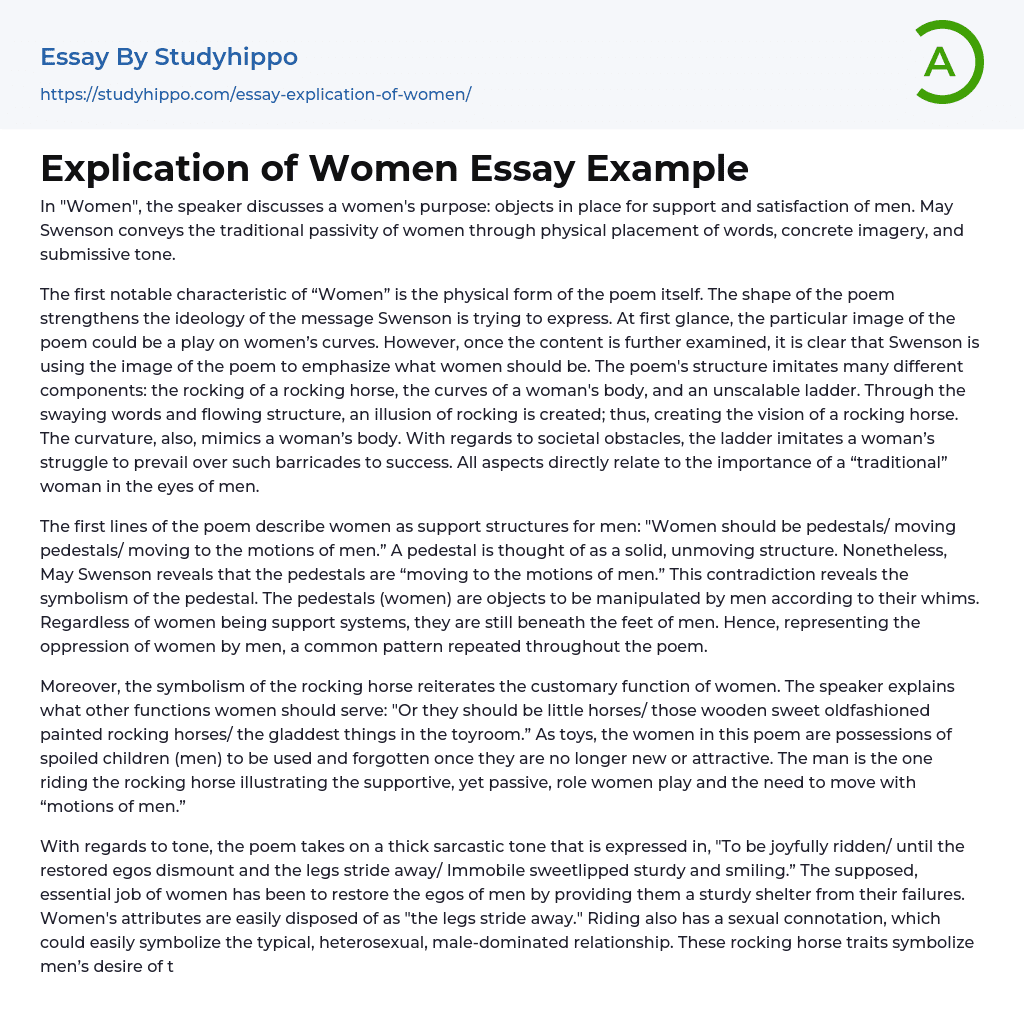In "Women", the speaker discusses a women's purpose: objects in place for support and satisfaction of men. May Swenson conveys the traditional passivity of women through physical placement of words, concrete imagery, and submissive tone.
The first notable characteristic of “Women” is the physical form of the poem itself. The shape of the poem strengthens the ideology of the message Swenson is trying to express. At first glance, the particular image of the poem could be a play on women’s curves. However, once the content is further examined, it is clear that Swenson is using the image of the poem to emphasize what women should be. The poem's structure imitates many different components: the rocking of a rocking horse, the curves of a woman's body, and an unscalable ladder. Through the swaying words and flowing
...structure, an illusion of rocking is created; thus, creating the vision of a rocking horse. The curvature, also, mimics a woman’s body. With regards to societal obstacles, the ladder imitates a woman’s struggle to prevail over such barricades to success. All aspects directly relate to the importance of a “traditional” woman in the eyes of men.
The first lines of the poem describe women as support structures for men: "Women should be pedestals/ moving pedestals/ moving to the motions of men.” A pedestal is thought of as a solid, unmoving structure. Nonetheless, May Swenson reveals that the pedestals are “moving to the motions of men.” This contradiction reveals the symbolism of the pedestal. The pedestals (women) are objects to be manipulated by men according to their whims. Regardless of women being support systems, they are still
beneath the feet of men. Hence, representing the oppression of women by men, a common pattern repeated throughout the poem.
Moreover, the symbolism of the rocking horse reiterates the customary function of women. The speaker explains what other functions women should serve: "Or they should be little horses/ those wooden sweet oldfashioned painted rocking horses/ the gladdest things in the toyroom.” As toys, the women in this poem are possessions of spoiled children (men) to be used and forgotten once they are no longer new or attractive. The man is the one riding the rocking horse illustrating the supportive, yet passive, role women play and the need to move with “motions of men.”
With regards to tone, the poem takes on a thick sarcastic tone that is expressed in, "To be joyfully ridden/ until the restored egos dismount and the legs stride away/ Immobile sweetlipped sturdy and smiling.” The supposed, essential job of women has been to restore the egos of men by providing them a sturdy shelter from their failures. Women's attributes are easily disposed of as "the legs stride away." Riding also has a sexual connotation, which could easily symbolize the typical, heterosexual, male-dominated relationship. These rocking horse traits symbolize men’s desire of the “traditional” women to be confined, valued for their beauty, and ready to serve.
Conclusively, the last few lines are laced with bitterness: “"women should always be waiting/ willing to be set in motion/ Women should be pedestals to men.” The speaker is sarcastically agreeing to the whims of men. Swenson describes women as “always waiting,” a very drastic change from moving pedestals and rocking horses. The
message is very clear with regards to the social standards of women. Women are destined to be passive yet supportive in the “traditional eyes of society”, symbolized by the moving pedestal. They are expected to be treated as “the gladdest things in the toy room,” symbolized by the rocking horse. At the heart of the poem, the aesthetic form, tone, and symbolism mimics the expected womanly attributes valued by men in a traditional sense.
- Academia essays
- Higher Education essays
- Language Learning essays
- Studying Business essays
- Education System essays
- Study essays
- First Day of School essays
- Scholarship essays
- Pedagogy essays
- Curriculum essays
- Coursework essays
- Studying Abroad essays
- Philosophy of Education essays
- Purpose of Education essays
- Brainstorming essays
- Educational Goals essays
- Importance Of College Education essays
- Brown V Board of Education essays
- The Importance Of Higher Education essays
- Online Education Vs Traditional Education essays
- Academic And Career Goals essays
- Academic Integrity essays
- Brown Vs Board Of Education essays
- Distance learning essays
- Technology in Education essays
- Vocabulary essays
- Writing Experience essays
- Importance of Education essays
- Early Childhood Education essays
- Academic Degree essays
- Academic Dishonesty essays
- School Uniform essays
- Academic writing essays
- Cheating essays
- Bachelor's Degree essays
- MBA essays
- College Life essays
- Grade essays
- Diploma essays
- Phonology essays
- Sentence essays
- Filipino Language essays
- Pragmatics essays
- Millennium Development Goals essays
- History Of Education essays
- Graduate School essays
- Middle School essays
- School essays
- Special Education essays
- University essays




